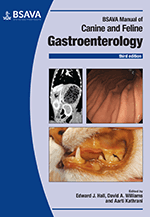
Full text loading...

Secretion of digestive enzymes is the major function of the exocrine pancreas. Normally, the pancreas very effectively protects itself against autodigestion by several mechanisms; however, when these protective mechanisms are disrupted pancreatitis can develop. This chapter covers anatomy, biochemistry and physiology; nodular hyperplasia; pancreatitis; exocrine pancreatic insufficiency; exocrine pancreatic neoplasia; pancreatic parasites and pancreatic bladder.
Exocrine pancreas, Page 1 of 1
< Previous page | Next page > /docserver/preview/fulltext/10.22233/9781910443361-3e/BSAVA_Manual_Gastroenterology_3_9781910443361-3e.36.231-243-1.gif

Full text loading...







